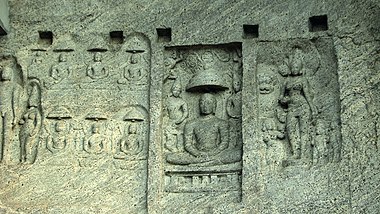Jainism in Kerala
| Part of a series on |
| Jainism |
|---|
 |
Jainism, one of the three most ancient Indian religious traditions still in existence, has very small presence (0.01%) in Kerala, in south India. According to the 2011 India Census, Kerala only has around 4500 Jains, most of them in the city of Cochin, Calicut and in Wayanad district.
Medieval Jain inscriptions are mostly found on the borders of Kerala proper, such as in Wayanad in the north-east, Alathur in the Palghat Gap and Chitharal in Kanyakumari District. Epigraphical evidence suggests that the shrine at "Tirukkunavay", perhaps located near Cochin, was the major Jain temple in medieval Kerala (from c. 9th century CE). The so-called "Rules of the Tirukkunavay Temple" provided model and precedent for all other Jain temples of Kerala.[1]
Some of the Jain temples in Kerala were incorporated by the Hindus at a later stage. The temple images are worshiped as Hindu gods and considered as part of the Hindu pantheon. It is not uncommon for Hindus and Jains to worship their deities in the same temple.[1]
History
Jainism in Iron-age/early historic Kerala
It is possibility that Jainism arrived in modern-day Kerala in the third century BCE soon after Maurya emperor Chandragupta Maurya (died c. 297 BCE), accompanied by Jain sage Bhadrabahu I, made the pilgrimage to Sravana Belgola (in present-day Karnataka). Their followers might have journeyed further south, into present day Tamil Nadu and Kerala.
A number of caves, donated by the early historic Chera chieftains to the Jains, can be found in the Karur-Pugaliyur region of western Tamil Nadu. Utiyan Cheral Atal, a Chera chieftain, is stated to have (Akam 55, Puram 65 and 66) died by starvation through a practice (the vattakku-irikkal) similar to the Jain sallekhana vrata. Utiyan Cheral was wounded on the back by his Chola rival Karikala in a battle.[1]
Late medieval to early modern Kerala


Ilamko Atikal, who is traditionally credited as the author of the Tamil epic Chilappatikaram, was probably a resident of a Jain vihara known as "Kunavayir kottam". Some scholars identify Kunavayir kottam with Tirukkunavay[il] or Trikkana Matilakam, now known as Matilakam, a village near Cochin. Matilakam was also known as "Gunaka" and "Kunaka" in the medieval period (Kokasandesa, slokas 45-48).[1] Archaeological excavations conducted at Matilakam in 1970, revealed an 8th-9th century CE foundation, structurally different from the standard Hindu temple foundations in shape.[1]
Whether it was the same as the kottam at Kunavay or not, epigraphical evidence suggests that the shrine at Tirukkunavay was the major Jain temple in Kerala. It is assumed that the so-called "Rules of the Tirukkunavay Temple" provided model and precedent for all other Jain temples of medieval Kerala. A dating system known as the Tirukkunavay Era was also present during this period.[1]
Inscriptions mentioning the Tirukkunavay[1]
- Tiruvannur/Tirumannur Inscription: royal order of the Chola emperor Rajaraja I (c. 1044 CE), from Tiruvannur Temple, near Calicut (the temple is a now Siva temple)[1]
- Alathur (Godapuram) Inscription (c. 11th century) - Images of Mahavira with the Gandharvas, and Parsvanatha have been recovered from Alattur.[1]
- Talakkavu Inscription: from Talakkavu in Putadi, Wynad (dated in the 137th year of the Tirukkunavay Era ~ dated to c. 850 CE). The location of the Jain temple is now lost to the scholars.[1]
- Kinalur Inscription (1083 CE) - connects Kota Ravi "Vijayaraga" (c. 883 - 913 CE),[1] the Chera king at Kodungallur, with "Kunvay-Nallur". The location of the Jain temple is now lost to the scholars.[1]
Based on the Talakkavu Temple Inscription, it is calculated that the Tirukkunavay Temple was founded some time at the close of the 7th or the beginning of the 8th century CE. It seems that by 15th century, the Tirukkunavay Temple was transformed to a Siva temple (Kokasandesa, slokas 47-48). The deity of Kunaka is called "Purari" in the poem Kokasandesa. The location of the temple is now lost to the scholars (the temple was probably destroyed completely in late medieval period).[1]
The Chathurmukha Basati, Manjeshwar near Bengere traces its history to patronage to Jainism given by a jain dynasty present in the region in 12th century. This temple got modified to present stature in late 18th century.
Other Hindu temples in Kerala with Jain characteristics are
- Kallil, Perumbavoor - Images of Mahavira, and Padmavati (worshiped as the Bhagavati) and Parsvanatha can be found in the temple.[1]
- Paruvasseri, Peechi (Palliyara Kavu Bhagavati Temple)[1]
- Kaviyoor Guha Kshetram, Pathanamthitta district, Bhagavati Temple, Tiruccanattu Malai, Chitharal, Kulithura - Images of Mahavira, Devi (destroyed) and Parsvanatha can be found in the temple.[1]
Jainism in modern Kerala

Some Jain shrines from early historic and medieval times still remain, notably in Jainamedu, near Vadakkanthara, Palghat, and in Sultan Battery in Wayanad. Koodalmanikyam Temple in Irinjalakuda is believed to have been a Jain temple. The assumption is that it was dedicated to Bharateswara, a digambara Jain monk.[2] Some Jain temples located in modern-day Kerala are: Anantnath Swami Temple (Puliyarmala Jain Temple) in Puliyarmala, outside Kalpetta; Jain Temple, Kidanganad, Wayanad; Jainimedu Jain Temple; Kattil Madam Temple; Jain temple, Alappuzha; Kallil Temple in Perumbavoor; Kochi Jain temple, Mattancherry; Shri Vasupujya Swami Jain Temple, Srinivasa Mallan Road, Kochi; Cochin Digambar Jain Mandir, Panampilly Nagar, Kochi; Chathurmukha Basati, Manjeshwar; and Parswanatha Basati, Manjeshwar.
Photo gallery
-
Visnugudi Basadi Jain Temple, Panamaram
-
Jain art & carvings at Chitharal Jain Temple
-
Jain temple in Manjeshwar
-
Shri Vasupujya Swami Jain Temple
See also
References
- ^ a b c d e f g h i j k l m n o p Narayanan, M. G. S. Political and Social Conditions of Kerala Under the Cēra Perumāḷs of Makōtai (c. AD 800 - AD 1124). Thrissur (Kerala): CosmoBooks, 2013. 340-42.
- ^ Sreedhara Menon, A. (1 January 1980). Cultural heritage of Kerala: an introduction - A. Sreedhara Menon. Retrieved 2 June 2012.
External links
| External videos | |
|---|---|









